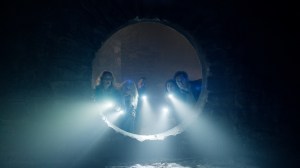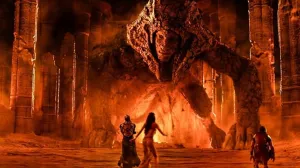
What happens when you blend SRPG and JRPG mechanics with an Edge of Tomorrow-style rebirth cycle and put it in a Star Wars-like space opera setting with a pixelated aesthetic? You get Star Renegades, the new tactical squad-based rogue-lite RPG developed by Massive Damage and published by Raw Fury. The game is a kit-bash of elements from other games, hoping to find something that feels fresh by combining mechanics from other successful titles. The result is a game with a brilliant battle system hampered by repetitive play patterns and insufficient reward for the time invested.
Videos by ComicBook.com
Star Renegades opens with a brief tutorial that has players taking control of two mech pilots defending against a sudden and unexpected invasion. The game renders its world in pixelated visuals similar to Hyper Light Drifter, Superbrothers: Sword & Sworcery EP, and Duelyst. The battle soon takes a turn for the worst, but all is not lost. These are not interstellar invaders, but interdimensional conquerors. A brilliant scientist figures this out, encodes a message into a small, determined robot, and sends the robot into the Imperium’s next target dimension to contact her alternate reality self. This first reality may be lost, but they may be able to save the timeline after this one.
This story device justifies the game’s progressive restarts, which is similar to the respawn system of Into the Breach. The combat is something else entirely. Instead of grid-based battles, Star Renegades‘ action takes turn-based, tactical form, similar to Darkest Dungeon. Combat is deterministic, and you always know what your opponent is going to do and when they will do it. The game encourages you to act first as, by hitting an opponent before they hit you, you score a “crit,” delaying an enemy’s attack and piling on extra damage and other effects. If you do that enough times, you can even “break” their action, pushing it into the next round. But you have to be careful and think hard because you can delay your opponents only a limited number of times in a row, and they can score crits as well by hitting you first.
Those are the basics, but there’s a lot more to the combat system. There are many different character classes, each with its strengths and weaknesses, but you can only choose three to start. There are different damage types, which enemies may be vulnerable to or resist. By the second planet, you have to start worrying about positioning since only some attacks can reach the back rows of combat without mowing down the characters or enemies in the front row first. There are three different forms of health to keep combatants alive. Shields can be easily knocked out and regenerated, and armor reduces damage. Both of those protect your health. Some attacks do standard damage while others attack armor directly, hoping to cause an armor break by lowering an enemy’s armor to zero.
If it sounds like a lot to take in, that’s because it is. Star Renegades‘ battle menus are busy and hard to parse at first. I was hours and multiple playthroughs into the game and still learning what some of the symbols and menus meant. But even as I was putting things together, the game’s combat was immediately challenging and engrossing, forcing me to weigh my offense and defense in equal measure and always to sweat the details.
Star Renegades also employs an Adversary system similar to the one found in Middle-earth: Shadow of Mordor. Each planet’s map has a few more formidable enemies with ranks like lieutenant and commander. Face them and win to gain great rewards. Face them and lose, and they’ll receive a promotion and return even more powerful than before to haunt you in another timeline. Sometimes they’ll even be resurrected from the dead. It adds a fun sense of melodrama to the campaign, and beating these enemies is immensely satisfying.

The tactical nature of the game applies even to its intercharacter social aspect. Between each day of grinding through the map, you make camp, and your characters can interact with each other. While it looks like something out of Dragon Age: Origins on the surface, it plays out much differently. Your characters each have unique interaction cards that grant bonuses and cost different amounts of your action limit to play. In addition to the immediate rewards, playing cards between characters build those characters’ relationships, which can unlock additional permanent bonuses and combo attacks.
It’s a deep game with fun combat, but the shine wears off after a while. As mentioned, Star Renegades borrows the time-travel mechanic of Into the Breach. But where Into the Breach‘s graceful, simple design made every combat feel like it mattered, Star Renegades complicates the system. It takes some of its design cues from JRPGs, including the sense that most of the game’s battles are there solely to level you up and wear you down ahead of the boss fights. Combat in the game is always engaging and making one wrong move, especially against an Adversary, can spell an early demise, but the enemy groupings you face don’t seem to vary all that much from one playthrough to the next. Despite supposedly being “procedurally generated,” the maps were nearly identical each time around as well. Since the game also locks the number of areas you can explore before forcing you into the boss fight, you have little choice over how much time to spend leveling and improving your characters.
In my experience, I got to where I could get through the first two levels of the game consistently, but the second boss battle remained a challenge. I’d spend a lot of time playing through those first two levels relative to the single, often catastrophic combat with the second boss, which was the only battle that mattered. It became frustrating to have to spend that much time grinding through levels I’d already played through to see if whatever adjustments I made to my party this time around was enough to get by the boss that held me back.
It doesn’t help that Star Renegades takes many progression decisions out of players’ hands. For example, the different characters unlock in a fixed order. The bonuses you earn from repeated playthroughs are also acquired in the same fixed order and only apply to a single class. If your latest bonus doesn’t apply to a character that you want in your party, it feels like you’ve earned nothing for your time. While you start with three characters in your party, you can add another after defeating each boss, but you’re only allowed to choose from two (or three with an upgrade) randomly selected classes. That makes it frustrating trying to plan for later battles beyond the first world.
These factors add up to a game that starts strong, but that can quickly become a frustrating and repetitious experience. I allow for the possibility that Massive Damage’s target demographic for Star Renegades are players who will have an easier time progressing through the game and thus won’t spend as much time replaying the same sequences. But it is a game with repetition built into its DNA. Therefore, it feels fair to criticize the game when that repetition begins to feel like a chore. Despite all of that, the game’s depth is impressive. It’s remarkable how every system, from character selection to movement on the map to the campfire conversations are all interlinked and can make a significant difference in your success or failure. If the game’s respawn system were a bit more forgiving, or the playthroughs more varied, this could be an absolute success. As it is, hardcore grinders are the most likely to appreciate this cyclical adventure.
Rating: 3 out of 5
Star Renegades releases on PC on September 8th. A PC review code was provided by the publisher for the purpose of this review.








